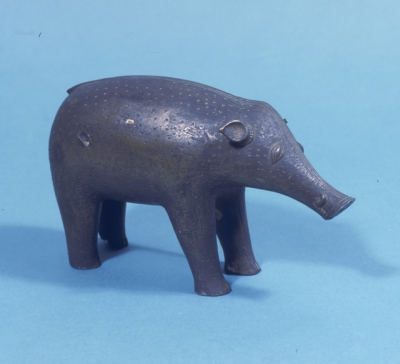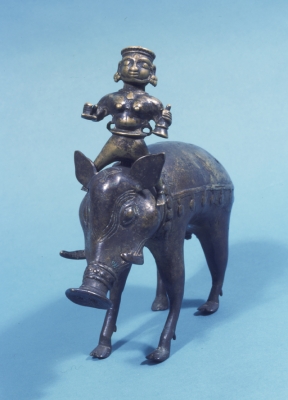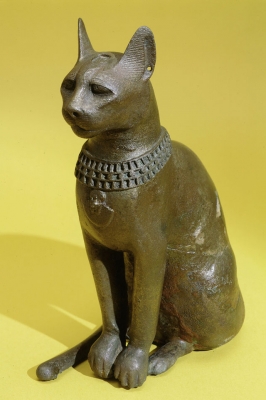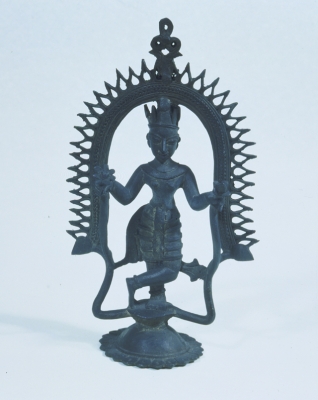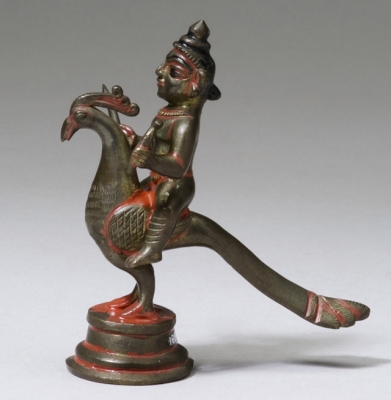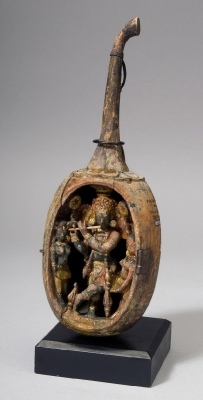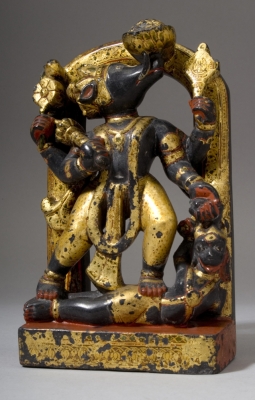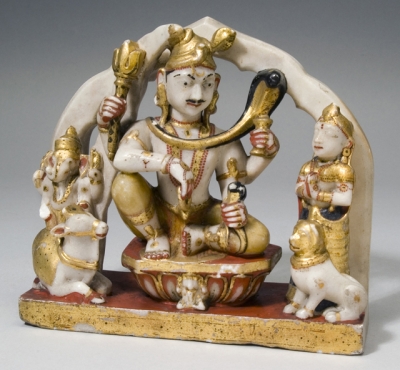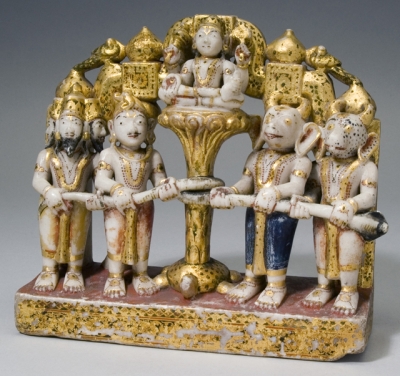To search the RPR site click here
Detailed museum documentation
The following article was written when the first Pitt-Rivers research project, funded by the Leverhulme Trust, in the 1990s had been completed by the project researcher, Alison Petch. She has continued to update it ever since when new information is known.
The documentation of the Pitt-Rivers founding collection is exceptionally confusing, especially when it dates from before it arrived in Oxford as there is very little straight-forward explanation for the odd decisions that were taken regarding numbers. The following is the current understanding of the system, if you have any additional information then please send it to This email address is being protected from spambots. You need JavaScript enabled to view it.
What do the founding collection entries on the museum's collections management computer system contain?
The founding collection entries contain all the entries in PRM [Pitt Rivers Museum] Accession books IV - VI and a number of other entries for objects from the founding collection listed in other accession books, or unentered when the original accession books IV to VI were prepared and subsequently added. The accession book entries have been matched to other entries from other primary sources such as the Pitt Rivers published catalogue [1874], Blue, Black, Red and Green books etc. This information should enable future researchers and museum workers to see at a glance the different primary source entries and the historical layering of information about each object. There are also some items from Pitt Rivers’ overall collection in PRM. That is, items that were not part of the founding collection but received later or else purchased or donated from another source but believed to be part of PR’s own private collection or from Farnham.
What does the PRM possibles file (an internal museum database) contain from the founding collection?
Objects were found to be listed in the Pitt Rivers 1874 catalogue, the black red and blue books, delivery catalogues etc which did not match any existing catalogue entries listed in the Accession Books IV to VI (now entries in the PRM collections management system). It is not known whether these objects actually were transferred to the Museum but an assumption has been made that they were and that, for whatever reason, they were not entered. The fact that since this file was prepared some 1000 artefacts have been identified, matched and accessioned from the founding collection supports the fact that most, if not all, the objects listed in this file will eventually be found at Oxford. Where these objects are listed in the Delivery Catalogues it could be safely assumed that they were received at the PRM, however some of the descriptions in these catalogues are so different from the ones in Accession Books IV to VI that it is possible that a match is possible but has not been identified. As actual objects are found which match these entries they are added to the Accession Book VIII [as 1884.140.??].
Computer entries made before the first Leverhulme Trust-funded Pitt Rivers cataloguing project
Computerised records for the North American Pitt Rivers collection were originally entered by Linda Mowat (Assistant Curator, Documentation, 1984-1994) (and partly by Sally Seguin, an intern c1990-1991 ); Australian objects were originally entered by Linda Mowat; Sandra Dudley (D.Phil student in the department, part-time Museum Assistant and later part-time researcher) originally entered the Burmese objects. Some other entries were originally computerised by Linda, Sandra, Marina de Alarçon (museum assistant from 1993), Jeremy Coote (Assistant Curator, Documentation from 1994) and Alison Petch (Researcher 1990 on). Some of the archaeological entries were originally computerised by students at the Quaternary Centre then at 60 Banbury Road, and by Pamela Wace. Note that all these previously entered computer entries were amalgamated into the new entries and the original information supplemented by a great deal of additional information.
Four-figure numbers
Some objects seem to be associated with one to four figure numbers. These seem to be a continuation of the numbering system used in the Pitt Rivers 1874 catalogue which gave details about objects numbered from 1 to 1247. No further information about this numbering system is known at the present time except that where an object is associated with a one to four figure number it is not usually associated with an Ag number or Fraction number. It is not known how this system conforms with South Kensington Museum [SKM] contemporary numbering systems.
Ag numbers and Fraction Numbers
In the red, blue and black books and sometimes in the Delivery Catalogues objects are given an 'Ag' number. Beatrice Blackwood suggested in Origin and Development that 'Ag' stood for Aggregation - that is, sum or total [but see on]. The green book has made it clear that objects with the same date are often given the same Ag number. At the beginning part of the book the objects are associated always with Ag numbers. Later on (after page 120 29.9.1879) the association changes to dates being linked with specific ends of fraction numbers. I think that the Ag numbers and fraction numbers are part of one series. The first part of the fraction number is however many objects have been listed against that particular end fraction number. So that the number 1/ 12395 is the first object to be matched against the end fraction number of 12395. The fraction numbers clearly follow on from the Ag numbers which also increase over time. The first entry in the green book specifically associated with an 'Ag' number is on page 3 [14.2.1874] which is associated with 'Ag' 122. From there the numbers increase with each receipt [and over time] to a top 'Ag' number of 9974 [page 119 15.9.1879] the first fraction number starts on page 120 with 10010. It seems likely that the fraction numbers are some sequential count of objects but obviously an end fraction number or an 'Ag' number are associated with up to around 200 objects. However it might be that the first number eg 1/ 10010 is in fact the 10010 object in the Pitt Rivers collection. Certainly Blackwood's association of the term ‘Ag no’ with Aggregate would support this theory. Who assigned the numbers and devised the system is not known. At the present time nothing further is known about the details of the fraction numbers etc.
S numbers
These are always four figure numbers preceded by the letter capital S. They appear to be always numbered 13. It appears to stand for ‘Screen’ whatever number; an example would be in 1884.54.40 where an entry reads: Delivery Catalogue I entry - Remains of a British canoe with skull of animal on stand S 1351 Not in case 116’
Pitt Rivers' own use of these numbers
Whether or not the 'Ag' and fraction numbers were assigned by Pitt Rivers or used as a system at the South Kensington Museum and merely agreed by him, in a few of the Cambridge University Library catalogue entries there is reference to fraction numbers. This means that at the very least Pitt-Rivers must have been aware of this system though he did not continue to apply it for his second collection. An example of this from the catalogue of the second collection:
‘14 July 1882 Objects removed from South Kensington Museum
1 Sword ...gari (illegible) work Deposited at G.G. [Grosvenor Gardens] Office case Transferred to Landing XII Rushmore 19.10.[18]82 used in decoration mantel piece Inner Hall
1 Antique bronze dog (2765) Deposited at Library mantel [sic] shelf
1 Bronze Costume of English Mail and Plate Armour IV cent 178 / 8386 Deposited at G.G. Lift room Drawer No. 12 Transferred to Rushmore 1887 Museum Room 7 Case 75
1 Bronze vase 32 / 12099 inscribed LOF.GODT.VAN.ANNO.1604 4 1/2 inches height Deposited at Library Mantel shelf Transferred to Rushmore Room 3 on Sideboard 19 Oct 1882
6 Terra Cotta ... [illegible] Lamps 1 - 6 / 12395 Deposited at Drawing Room case’
It is not clear why some of these objects have numbers and some do not. Note that none of the above items returned to the founding collection and are therefore not in the Pitt Rivers Museum, Oxford, collections today. Also note that the remainder of the / 12099 and / 12395 items remained with the founding collection. The fact that Pitt-Rivers did not use this number systems suggests that the numbers were associated with the South Kensington Museum and therefore might have been assigned by that place rather than Pitt Rivers himself.
If the one to four figure numbers and fraction numbers do constitute a bizarre way of counting the total number of objects in the South Kensington Museum from Pitt Rivers, then this would suggest that the final count was roughly above 14860 as this is the last fraction number that I can find (it has 36 artefacts associated with it, suggesting that the total count must have been in excess of 14,896). However, this would definitely be an underestimate of the number of objects that were in the founding collection as in 2010 there were probably in excess of 23,000 objects in the Pitt Rivers Museum at Oxford. [1] It is known that a very small number of items (mostly artefacts made from gold or agricultural implements) were present at Bethnal Green / SKMs but did not transfer to Oxford.
PRIMARY SOURCES USED IN COMPILING THE PR CATALOGUES PARTS I AND II
1. ‘Green book’: Pitt Rivers Collection: South Kensington Museum Receipts
These were written by the staff at Bethnal Green and South Kensington Museums as the objects were received from Pitt Rivers. This book seems to be a number of photocopies (bound in a green cloth cover hence my appellation of ‘green book’) of receipts given by South Kensington Museum to Lane Fox (as he then was) from 1st January 1874. Each page (or series of connected pages) is a separate receipt and each is dated. The receipts are signed by the receiving Store keeper at SKM (or Bethnal Green branch of that museum) and also signed by another member of the Museum’s staff. There are a large number of batch entries and it is not possible to give an accurate count of how many objects are listed. Because the green book identifies objects received at Bethnal Green and South Kensington it does not necessarily follow that all of the objects therein transferred to the PRM. Blue, black and red books make it clear that some were returned to Pitt Rivers for his private collection. How these entries relate to the Black, blue and red books is unknown. All such objects have an entry in the notes field saying 'Displayed in Bethnal Green and South Kensington Museums (V&A)' or 'Displayed in South Kensington Museum (V&A)' for those dated after 1878. See section on fraction numbers above. Note that the green book entries and Pitt Rivers catalogue [1874] entries seem mutually exclusive. Presumably this is because the 1874 catalogue lists those items already at Bethnal Green by 1874 whilst the Green book (Van or Day books from Bethnal Green) lists those items which were delivered to Bethnal Green after that date. The only exceptions to this are those items listed in the green book as arriving in 1874 which if they are the type of objects mentioned in the 1874 catalogue are often matched to both and also some items which were obviously in Bethnal Green in 1874 and were then removed by Pitt Rivers and returned and re-recorded as coming back in the Green book.
2. Black, Blue and Red books:
These were books written at Bethnal Green Museum / South Kensington Museum [SKM] and must either reflect the thinking of staff at that museum or of Pitt Rivers himself. The black, blue and red books were originally notebooks with covers of the relevant colour. On the right hand pages of each one is a catalogue of the first and largest batch of objects sent by General Pitt Rivers to South Kensington Museum entered in groups according to subject with consequent numbers and on the left hand pages of each one specimens in the same subject groups sent subsequently with numbers prefixed by Ag. [Aggregation] These notebooks were the personal jottings of W. Hill and not part of formal Bethnal Green documentation. He sent them to the Pitt Rivers Museum in 1884 in case they were of interest. These were later collated by E.S. Thomas with Accession Books IV, V and VI. It is not clear how Thomas collated the Black etc entries against the objects and whether he did so by visual reference to the objects, some (?all) of the objects are so numbered (that is 1 in black writing, 233 in red etc) gives the collated Blue black or red number if known. In some instances these matches (often given on object labels as well as in the accession books) were wrong and cannot be relied on. Blackwood’s book on Origin and Development implies that Thomas matched all objects but this was not so when checked for during computerisation process. Where objects have a Black, Blue or Red entry an entry has been made into each such record saying: 'Displayed in Bethnal Green and South Kensington Museums (V&A)'. This has also been done for those objects with Ag numbers. Note that many of the objects listed in these books are cross-referenced to the Pitt Rivers 1874 catalogue entries by the same numbers and by other four digit numbers also often given on the object and in the Accession book entries. It is possible that as these were presumably written into the Black, red and blue books as the objects were received at Bethnal Green these numbers were assigned by Pitt Rivers prior to them being sent to Bethnal Green (they are not numbered consecutively in the Black etc books).
Note that the case number given in the Black book entries in the PRM collections management system has been taken from the 'code' C.81 [for 1884.1.1 for example] and for some entries S.[number]. Because some black book entries have matching Pitt Rivers 1874 catalogue entries, and these give the Case or Screen number, and in most cases it agrees with the code it is obvious that 'C' stands for 'Case' and 'S' for 'Screen' for the displays in Bethnal Green Museum. Some black book entries do not have this information but it is not known whether this means that the object was not displayed at Bethnal Green or whether it just means that a note was not made of the relevant case or screen number. Where the title of the section of the black book introducing a certain number of objects was interesting [i.e. not simply descriptive as in ‘Knives’ etc but a title illustrating some form of intellectual basis for the arrangement of objects these have been added to the relevant entries for each object in the section.
All entries that have not been matched from the blue, black and red books to the founding collection entries on the PRM collections management system have been placed in the PRM possibles internal database. It should be possible when each object from the collection has been physically accessed for these unmatched entries to be reassessed and assigned as appropriate.
A letter in front of the Delivery Catalogue I [and in Archives] is a transcription from W.J. Hill, Science Museum, to Professor H.N. Moseley dated 27.7.1886 says that the catalogues are ‘two rough manuscript catalogues of objects in the PR collection’, the numbered pages were written for the most part from descriptions furnished (he presumes) by PR himself on forwarding first and largest batch of his objects to the Museum and on the unnumbered pages will be found descriptions of objects received at subsequent dates and some rough notes generally in brackets ... Although this was placed in the Delivery Catalogue it seems a better description of the black, red and blue books to me.
3. Delivery Catalogues I and II:
Blackwood in Origin and Development states that the two volumes of Delivery Catalogues indicate what was given to the University by Pitt Rivers in 1884. According to Chapman, 1981: 682, the books were written by W.R. Groser the SKM storekeeper. Entries are made in the order in which objects were put into the packing cases, with the General's numbers appended, all the entries (with a few exceptions) were supposed to have been incorporated into PRM accession books IV, V and VI. In fact a substantial number of some parts of the catalogues cannot be matched to existing entries. It should also be noted that the entries in the delivery catalogue are often mistranscribed (that is the writer miswrote numbers etc that appeared on artefacts) so entries cannot be relied on for accuracy. All entries that have not been matched from the delivery catalogues to the founding collection entries on the collections management system have been placed in the PRM possibles internal database. Note that a very few items appear to have two matching delivery catalogue entries, this particularly applies to spears, it is not known how or why this should be. It has to be assumed that the delivery catalogue lists were compiled as items were placed in the packing cases as these are listed by number against the entries. This should mean it would not be possible to duplicate entries.
4. Accession book III:
Comprises objects from the Andamanese and Nicobarese Islands, India. It is a Catalogue dated January 1881 of objects from these Islands collected by E.H. Man and presented by him in November 1880 to General Pitt Rivers. It was sent to the Curator of the PRM in 1941 by the Keeper of the Library of the Victoria and Albert Museum, all these objects were also entered in PRM accession books IV V and VI. The book is headed: 'Catalogue of Andamanese and Nicobarese objects presented to Maj. General Pitt Rivers FRS etc Nov. 80 Andamanese objects' with a note 'Except otherwise specified these objects are those in use among the people of South Andaman. Many of them are believed to differ but slightly if at all from those employed by the other 7 Great Andaman tribes, the chief diversities being ... [sic illegible] among the Little Andaman and other Jarawa tribes'. The frontispiece of the book states 'Catalogue of the Andamanese and Nicobarese objects presented to Genl. Pitt Rivers' collection at the South Kensington museum Jan. '81'. Note that the items have been matched against all E.H. Man Andaman objects and it may therefore be that they have been matched in some instances to objects which were received after this date. The entire III catalogue was written by E.H. Man in Surbiton by January 1881.
5. Accession book IV, V and VI:
The Accession Books were handwritten and illustrated by Ernest Seymour Thomas, Assistant Curator at the Pitt Rivers Museum from the early 1920s. Despite many checks of the Annual Reports etc there seems to be no mention of this exercise (there is none in Blackwood’s Origin and Development either except for the fact that he compiled them) although it must have been a significant and time consuming task. They form a Catalogue of the collection presented by General Pitt Rivers to the University arranged in series according to subjects or typologies. They were supposed to incorporate all entries in from the delivery catalogues etc with the General's numbers (however, they do not). It is not known why approximately 7,000 objects were missed when the accession books were compiled (if current research is to be believed). Since the first Pitt Rivers research project in the mid 1990s, some evidence has come to hand that the catalogues might have been written using the displays. In other words, the book was completed by listing all items in particular displays. This still leaves unexplained how so many artefacts were missed as in the 1920s the museum did not have extensive stores where objects might have been missed or not included.
Accession numbers were not given prior to 1939 and therefore the Accession books were written originally without them and then the numbers were added. In some instances the accession numbers were assigned incorrectly; that is, two numbers were given to one object or insufficient accession numbers were given to a bulk entry. Where possible during computerisation these errors were corrected but in some instances it was not possible. As objects are retrieved and found not to have been listed in these accession books new accession numbers need to be assigned. It has been decided that all ‘new’ (found unentered) Pitt Rivers founding collection objects should be given the next sequential 1884.140 number.
6. Accession book VII:
Nicobar Islands EH Man collection. List of specimens given by Man either to General Pitt Rivers or to the University Museum in 1886, transferred to the Pitt Rivers Museum in 1887. Note that this is a question of semantics, the collection was sent to E.B. Tylor by Man, Tylor was deemed to be at the University Museum though in this case it may well be that the cases were always meant to come to PRM which had not then been fully differentiated from the Oxford University Museum of Natural History. The catalogue is headed 'Catalogue of Nicobarese objects for the University Museum October 1886'. The large amount of general information about the Nicobar Islands, the objects and the catalogue given in the front of the volume are included in the entry for 1884.81.12.
However it might be that the above statement is not quite accurate because a letter from E.H. Man in the PRM Archives gives the following information:
PRM Tylor papers B 13
27.10.86
EH Man to EB Tylor
With reference to the correspondence which took place between us a few months ago on the subject of a further collection of Nicobarese objects in order as far as possible to complete the set commenced by me a few years ago and now transferred from Sth Kensington to Oxford I beg to inform you that I am now despatching to your address a case measuring about 7 feet by 4 ft by 1 3/4 ft containing the objects numbered in black ink in the accompanying Catalogue (Column 1) which I am sending with a packet of photographs under registered cover. ....
As I thought you wd prefer that the Catalogue I have prepared on this occasion shd contain all the objects previously supplied I have adopted this plan and have also included mention of several other objects wh are either too bulky to send or wh can be sufficiently illustrated by means of photographs or a written description.
This would suggest that the Nicobar catalogue lists all Nicobar items from Man including the 1886 ones which are numbered in black. The Nicobar entries in the PR computerised catalogue now reflect this.
7. Collections Miscellaneous XI:
The contents of this volume were found by T.K. Penniman in various parts of the Museum and bound together after being checked with the objects. It contains many of the older collections of the Museum which had evidently been listed separately by different people. All entries were collated with other volumes and duplicate entries have been indicated. It also contains details about objects not part of the founding collection.
8. Card Catalogue:
Penniman and his colleagues copied, in duplicate onto index cards, the entries in the Accession Books before and during the Second World War. These formed the card catalogues, divided into geographical area and subject. Until the card catalogues were prepared the only source of information about the objects was in the Accession Books. Some of the contents of these cards have been incorporated in to the computerised catalogue of the Pitt Rivers collection (e.g. all cards for Cyprus, all Musical Instruments etc).
9. Balfour Catalogues, Vessels other than pottery, Fire-making and 3 of Music:
Note that the objects listed in five catalogues, 3 of which relate to Music, the catalogues were prepared by Henry Balfour, and the system discontinued in 1903. The three Music catalogues are Wind 130.A-K, Percussion 129 A-P and Strings 131 A-I. There are also two other catalogues, one entitled ‘Red numbers Containers other than pottery 104. A - L’ and ‘Red numbers Fire-making 117 A-R. All founding collection related entries have been entered in founding collection entries on the collections management system or (if appropriate) PRM possibles internal database. It is not known whether these are part of a larger series of catalogues [as the numbers starting at 104 would suggest] but a check in the Balfour Library, Documentation Centre and Archives has suggested that if there were further notebooks on other series these are no longer traceable.
10. Pitt Rivers 1874 Catalogue:
This refers to the catalogue of the collections displayed at Bethnal Green (and later the V and A) published in 1874 and republished in 1878. All such objects have an entry in the notes field saying 'Displayed in Bethnal Green and South Kensington Museums (V&A)'.
11. Subject card catalogues
A small number of index card catalogues were prepared for specific types of objects eg footwear, smoking accessories, and amulets. Some of these have been matched to the founding collection entries. These catalogues do sometimes contain more information than the accession books or the other primary sources.
Alison Petch
Leverhulme Researcher, ‘The founding collection of the Pitt Rivers Museum’ and 'Rethinking Pitt-Rivers' project.
Originally written in September 1998, added to August 1999, amended November 2004, addition made to the bit about Delivery catalogues in September 2009, generally amended October 2010; revised February 2013
Notes
[1] 22830 as at February 2013, this number is likely to increase over 2013 as the Excavating Pitt-Rivers project continues to find unentered items

